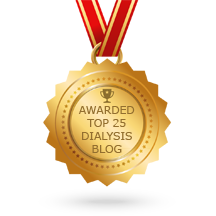So how did we get here? In my November dialysis team meeting we decided I needed to remove the parathyroid, a parathyroidectomy. The surgery would require an incision in my neck to remove the offending 1 or more of the 4 PTH glands. My neph also suggested a new method, a noninvasive method, ablation. I'll get into that later.
But. Because I have a HMO, I needed to get the referral from my primary care physician, PCP. I had an appointment with him in December. And asked for th referral. He was appalled that I asked for the referral. What a horrible idea and horrible surgery and surely there was a better way. And proceeds to google options (massive eye roll). He tells me to have my nephrologist contact him. ..and in the meantime my PTH levels are rising.
I relay the message to my nephrologist at my monthly December meeting. The next day I get a call from my nurse that my PCP has approved the request. Nephrologist - 1' Primary Care Physician - 0. I just needed to determine if wanted the parathyroidectomy or the ablation. I chose the ablation. Appointments made. Labs looked at and the ablation occurred yesterday. Two weeks ago an ultrasound was taken of my PTH glands. There are 4 of them. The one on my left side was enlarged. The doctor showed me as he was doing the ultra sound.
Yesterday I was back in the office. The ablation process is a needle with concentrated alcohol is inserted into the PTH gland and the alcohol shrinks the gland. Needles don't bother me. So the idea of a needle in my neck didn't concern me..much. Lol. When I was in ICU, I was getting blood thinning meds injected in my stomach(!). I digress. The procedure took 2 injections. The first was was uneventful. The injection itself didn't hurt. A local anesthetic was applied. I did feel the fluid going in. It was uncomfortable but not unbearable and didn't last long. The 2nd injection. I felt the fluid more and started coughing when the needle was removed. But. The procedure lasted less than 10 minutes. And that was it. The neph showed me the ultrasound of how the gland looked after the alcohol injection.
So how did tolerate this unusual needle sticks in my neck? Way back when, at all girls catholic high school, we had retreat at a house of local monks. They taught us the technique. I've used this tool my entire life to relax. It's worked for me all these years and I certainly used it yesterday. I regulate my breathing and went to my happy place. And it's the same place I went when we were learning!
And so here I am, doing treatment this morning. Still fighting the cold, but the procedure is over and now we'll see the results in about a month. I'm feeling good about what the results will show but I still have the surgery as backup if there are any issues.
Well that's it for today. The weather is still nice. Wore my open toe shoes during this warm spell when I got too lazy to put on shoes. Have a wonderful day!!




